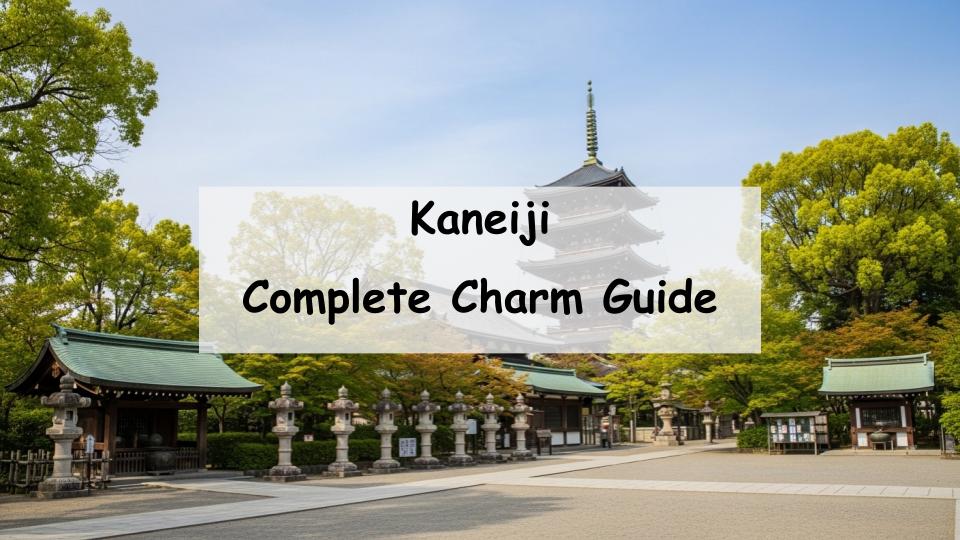Are you wondering, “What kind of temple is Kaneiji? What are its main attractions?”
Kaneiji Temple is a historically significant temple closely tied to the Tokugawa shogunate, boasting valuable architectural structures, notable gravesites, and beautiful gardens.
This article will provide a clear and easy-to-understand guide on Kaneiji’s historical background, architectural features, must-see spots, and access information. Nestled in the peaceful area of Ueno, this revered temple’s charm is waiting for you to explore.
What is Kaneiji? History and Basic Information
The Founding and Historical Background of Kaneiji
Kaneiji Temple was established in 1625 by the order of Tokugawa Iemitsu. Originally, it occupied a vast area in Ueno as Tōeizan Kaneiji, flourishing throughout the Edo period. It served as an important family temple for the Tokugawa shogunate, attracting many monks and followers. Kaneiji was more than just a religious site—it was also a political and cultural center during its heyday.
Deep Connections with the Tokugawa Shogunate
As the Tokugawa family’s bodaiji (funeral temple), Kaneiji houses the graves of many shoguns and their relatives. It was protected and supported by the shogunate, making it an essential spiritual pillar of Edo (modern Tokyo). Visitors today can sense the power and faith that defined that era.
Kaneiji’s Current Role and Overview of Its Grounds
Though the temple’s grounds have shrunk from their original size, Kaneiji is now located within Ueno Park, welcoming many visitors. The site contains several buildings designated as important cultural properties and tranquil gardens that offer a peaceful atmosphere to experience history. Religious ceremonies continue here, attracting both worshippers and tourists.
Highlights and Features of Kaneiji Temple
The Five-Story Pagoda and Important Cultural Properties
The five-story pagoda, a symbol of Kaneiji, beautifully enhances the Ueno skyline. Standing about 40 meters tall, it is designated as an Important Cultural Property of Japan. The temple’s buildings showcase the height of Edo-period architectural craftsmanship and leave visitors in awe.
Relationship with Ueno Toshogu Shrine
Kaneiji’s grounds neighbor Ueno Toshogu Shrine, dedicated to Tokugawa Ieyasu. The two sites are historically intertwined, and visiting both offers a deeper understanding of the Tokugawa shogunate’s prestige. Toshogu Shrine’s splendid architecture complements Kaneiji’s solemn atmosphere perfectly.
Kaneiji’s Gardens and Natural Beauty
The temple’s gardens provide a serene space to enjoy seasonal beauty, especially cherry blossoms in spring and colorful leaves in autumn. Designed with Zen principles, the gardens offer visitors a chance to relax and reflect amid nature.
Gravesites of Famous Historical Figures
Kaneiji contains the tombs of many notable historical personalities, including Tokugawa shoguns. These gravesites are valuable historical landmarks that allow visitors to trace the legacy of Japan’s ruling class during the Edo period.
Architectural Style and Cultural Value of Kaneiji
Characteristics of Edo-Period Temple Architecture
Kaneiji’s architecture reflects typical Edo-period styles, featuring intricate wooden carvings and vermilion pillars. The grand yet refined design reveals the advanced building techniques and samurai culture influence of the time.
Buddha Statues and Artworks at Kaneiji
The temple houses many precious Buddhist statues and artworks. The main hall enshrines statues with significant historical and artistic value, offering insight into Buddhist art traditions.
Traditional Events and Festivals Preserved by Kaneiji
Kaneiji continues to host many traditional ceremonies and festivals throughout the year. These events attract devotees and tourists alike, providing opportunities to experience the temple’s living cultural heritage.
How to Access Kaneiji Temple
Access by Public Transportation
Kaneiji is conveniently located just a few minutes’ walk from JR Ueno Station and Ueno Subway Station. Signage around the area makes it easy for first-time visitors to find the temple without difficulty.
Parking Information for Visitors by Car
While several paid parking lots are available nearby, the Ueno area tends to be busy, so using public transport is recommended. If driving, it is wise to check parking availability in advance.
Combination Plans with Nearby Tourist Attractions
Kaneiji is close to popular spots such as Ueno Zoo and the Tokyo National Museum. Combining visits to these locations makes for a fulfilling day of sightseeing.
Practical Information for Visiting Kaneiji
Opening Hours and Admission Fees
Kaneiji’s opening hours typically run from 9 AM to 5 PM, with some seasonal variations. Many areas of the temple grounds are free to enter, making it accessible for anyone interested in history and culture.
Tips to Avoid Crowds and Best Times to Visit
Weekends and holidays tend to be crowded, so visiting on weekdays or early in the morning is recommended. The cherry blossom season in spring and the colorful foliage in autumn offer the most scenic views but also attract the largest crowds.
Nearby Dining and Facilities
The area around Kaneiji features numerous cafes and Japanese restaurants, convenient for a break after sightseeing. Ueno’s vibrant food scene provides plenty of options for visitors.
Fun Facts to Deepen Your Appreciation of Kaneiji
Historical Anecdotes and Stories about Kaneiji
Kaneiji has been the setting of political intrigue and cultural developments in Edo Japan, including the close relationship between Tokugawa Iemitsu and the Buddhist monk Tenkai. Learning these stories adds richness to your visit.
Cultural and Religious Significance of Kaneiji
Beyond being a temple, Kaneiji served as a spiritual backbone for the Tokugawa regime. Its importance extends into the realms of Japanese history and culture.
Seasonal Scenery and Events at Kaneiji
Kaneiji showcases unique beauty in every season—from cherry blossoms to snowy winter scenes. Seasonal events and illuminations offer fresh experiences year-round.






Comment